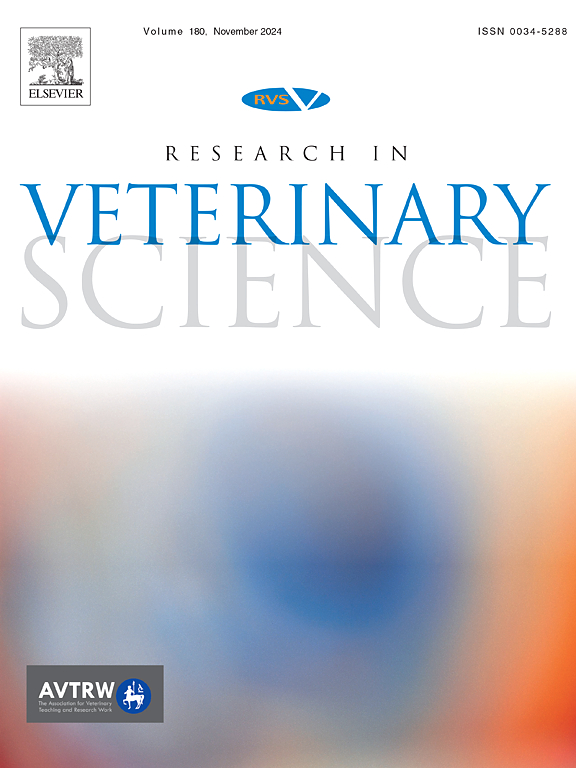Distinct amino acid substitutions in the EEV glycoprotein and DNA-dependent RNA polymerase of lumpy skin disease virus identified in wetland areas of Bangladesh
IF 2.2
3区 农林科学
Q1 VETERINARY SCIENCES
引用次数: 0
Abstract
The recent outbreak of lumpy skin disease virus (LSDV) in the wetland areas of Bangladesh presents a significant concern for both animal health and regional biosecurity. Epidemiological investigations into nine major outbreaks in the wetland areas revealed distinctive clinical symptoms in affected cattle, including elevated body temperature, excessive salivation, and the presence of skin nodules. Histopathological examination unveiled larger nodules compared to previous outbreaks, along with signs of secondary infection. Molecular analysis confirmed the presence of LSDV in all samples, with subsequent sequencing revealing genetic similarities with virus isolates of Bangladesh, India, China, Russia, Serbia and Greece. Most importantly amino acid variations in the viral EEV glycoprotein and DNA-dependent RNA polymerase were revealed that also altered the structures of the respective proteins significantly suggesting potential implications for viral pathogenesis. Additionally, successful isolation of LSDV in Vero cells demonstrated cytopathic effects, supporting the potential for vaccine development. In conclusion, this study provides comprehensive insights into the epidemiology, genomic characters with altered predicted structures of two major viral proteins and pathogenesis of LSDV outbreaks in Bangladesh. These findings emphasize the critical need for ongoing monitoring and adaptive control strategies, including the development of effective vaccines, to mitigate the impact of LSDV in affected regions and safeguard regional livestock health.
在孟加拉国湿地地区发现的肿块性皮肤病病毒EEV糖蛋白和dna依赖性RNA聚合酶的不同氨基酸取代
最近在孟加拉国湿地地区爆发的肿块性皮肤病病毒(LSDV)对动物健康和区域生物安全都提出了重大关切。对湿地地区9起重大疫情的流行病学调查显示,受影响的牛出现了独特的临床症状,包括体温升高、流涎过多和皮肤结节的存在。组织病理学检查显示,与以前的疫情相比,结节更大,并有继发感染的迹象。分子分析证实所有样本中都存在LSDV,随后的测序显示与孟加拉国、印度、中国、俄罗斯、塞尔维亚和希腊的病毒分离株具有遗传相似性。最重要的是,病毒EEV糖蛋白和dna依赖性RNA聚合酶的氨基酸变异也显著改变了各自蛋白的结构,这表明病毒的发病机制可能具有潜在的影响。此外,在Vero细胞中成功分离LSDV显示出细胞病变效应,支持疫苗开发的潜力。总之,这项研究为孟加拉国LSDV暴发的流行病学、两种主要病毒蛋白预测结构改变的基因组特征和发病机制提供了全面的见解。这些发现强调,迫切需要持续监测和适应性控制战略,包括开发有效的疫苗,以减轻LSDV在受影响地区的影响,并保障区域牲畜健康。
本文章由计算机程序翻译,如有差异,请以英文原文为准。
求助全文
约1分钟内获得全文
求助全文
来源期刊

Research in veterinary science
农林科学-兽医学
CiteScore
4.40
自引率
4.20%
发文量
312
审稿时长
75 days
期刊介绍:
Research in Veterinary Science is an International multi-disciplinary journal publishing original articles, reviews and short communications of a high scientific and ethical standard in all aspects of veterinary and biomedical research.
The primary aim of the journal is to inform veterinary and biomedical scientists of significant advances in veterinary and related research through prompt publication and dissemination. Secondly, the journal aims to provide a general multi-disciplinary forum for discussion and debate of news and issues concerning veterinary science. Thirdly, to promote the dissemination of knowledge to a broader range of professions, globally.
High quality papers on all species of animals are considered, particularly those considered to be of high scientific importance and originality, and with interdisciplinary interest. The journal encourages papers providing results that have clear implications for understanding disease pathogenesis and for the development of control measures or treatments, as well as those dealing with a comparative biomedical approach, which represents a substantial improvement to animal and human health.
Studies without a robust scientific hypothesis or that are preliminary, or of weak originality, as well as negative results, are not appropriate for the journal. Furthermore, observational approaches, case studies or field reports lacking an advancement in general knowledge do not fall within the scope of the journal.
 求助内容:
求助内容: 应助结果提醒方式:
应助结果提醒方式:


